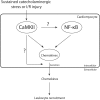Physiological and unappreciated roles of CaMKII in the heart
- PMID: 29905892
- PMCID: PMC6003982
- DOI: 10.1007/s00395-018-0688-8
Physiological and unappreciated roles of CaMKII in the heart
Abstract
In the cardiomyocyte, CaMKII has been identified as a nodal influencer of excitation-contraction and also excitation-transcription coupling. Its activity can be regulated in response to changes in intracellular calcium content as well as after several post-translational modifications. Some of the effects mediated by CaMKII may be considered adaptive, while effects of sustained CaMKII activity may turn into the opposite and are detrimental to cardiac integrity and function. As such, CaMKII has long been noted as a promising target for pharmacological inhibition, but the ubiquitous nature of CaMKII has made it difficult to target CaMKII specifically where it is detrimental. In this review, we provide a brief overview of the physiological and pathophysiological properties of CaMKII signaling, but we focus on the physiological and adaptive functions of CaMKII. Furthermore, special consideration is given to the emerging role of CaMKII as a mediator of inflammatory processes in the heart.
Keywords: Apoptosis; CaMKII; Calcium; Calmodulin; Cardiomyocyte; Inflammation.
Conflict of interest statement
The authors declare that they have no competing interests.
Figures


Similar articles
-
Role of CaMKII for signaling and regulation in the heart.Front Biosci (Landmark Ed). 2009 Jan 1;14(2):486-96. doi: 10.2741/3257. Front Biosci (Landmark Ed). 2009. PMID: 19273080 Review.
-
CaMKII signaling in heart diseases: Emerging role in diabetic cardiomyopathy.J Mol Cell Cardiol. 2019 Feb;127:246-259. doi: 10.1016/j.yjmcc.2019.01.001. Epub 2019 Jan 8. J Mol Cell Cardiol. 2019. PMID: 30633874 Review.
-
Ca(2+)/calmodulin-dependent protein kinase II (CaMKII) in the heart.Adv Exp Med Biol. 2012;740:685-702. doi: 10.1007/978-94-007-2888-2_30. Adv Exp Med Biol. 2012. PMID: 22453965 Review.
-
CaMKII is a nodal signal for multiple programmed cell death pathways in heart.J Mol Cell Cardiol. 2017 Feb;103:102-109. doi: 10.1016/j.yjmcc.2016.12.007. Epub 2016 Dec 24. J Mol Cell Cardiol. 2017. PMID: 28025046 Free PMC article. Review.
-
Ca(2+) /calmodulin dependent kinase II: a critical mediator in determining reperfusion outcomes in the heart?Clin Exp Pharmacol Physiol. 2014 Nov;41(11):940-6. doi: 10.1111/1440-1681.12301. Clin Exp Pharmacol Physiol. 2014. PMID: 25283076 Review.
Cited by
-
Deletion of obscurin immunoglobulin domains Ig58/59 leads to age-dependent cardiac remodeling and arrhythmia.Basic Res Cardiol. 2020 Sep 10;115(6):60. doi: 10.1007/s00395-020-00818-8. Basic Res Cardiol. 2020. PMID: 32910221 Free PMC article.
-
Transcriptome analysis of effects of Tecrl deficiency on cardiometabolic and calcium regulation in cardiac tissue.Open Med (Wars). 2024 Jan 23;19(1):20230880. doi: 10.1515/med-2023-0880. eCollection 2024. Open Med (Wars). 2024. PMID: 38283583 Free PMC article.
-
CaMKII Inhibition is a Novel Therapeutic Strategy to Prevent Diabetic Cardiomyopathy.Front Pharmacol. 2021 Jul 26;12:695401. doi: 10.3389/fphar.2021.695401. eCollection 2021. Front Pharmacol. 2021. PMID: 34381362 Free PMC article. Review.
-
JOSD2 mediates isoprenaline-induced heart failure by deubiquitinating CaMKIIδ in cardiomyocytes.Cell Mol Life Sci. 2024 Jan 10;81(1):18. doi: 10.1007/s00018-023-05037-7. Cell Mol Life Sci. 2024. PMID: 38195959 Free PMC article.
-
The YAP/SERCA2a signaling pathway protects cardiomyocytes against reperfusion-induced apoptosis.Aging (Albany NY). 2020 Jul 9;12(13):13618-13632. doi: 10.18632/aging.103481. Epub 2020 Jul 9. Aging (Albany NY). 2020. PMID: 32645692 Free PMC article.
References
-
- Backs J, Backs T, Neef S, Kreusser MM, Lehmann LH, Patrick DM, Grueter CE, Qi X, Richardson JA, Hill JA, Katus HA, Bassel-Duby R, Maier LS, Olson EN. The delta isoform of CaM kinase II is required for pathological cardiac hypertrophy and remodeling after pressure overload. Proc Natl Acad Sci USA. 2009;106:2342–2347. - PMC - PubMed
Publication types
MeSH terms
Substances
Grants and funding
LinkOut - more resources
Full Text Sources
Other Literature Sources
Research Materials

